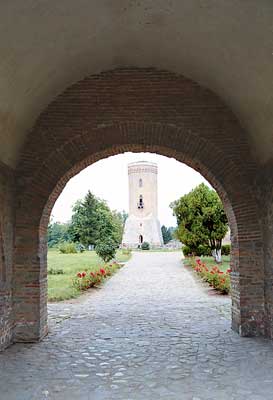
Looking through the entrance arch toward
Sunset Tower
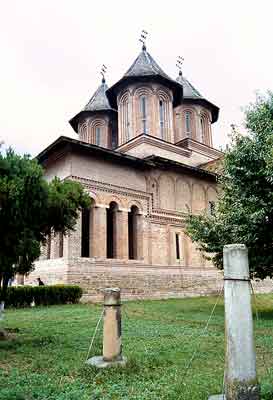
Princely Church
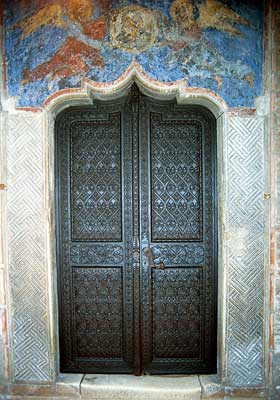
The church doors
Friday the 13th, and on to Bucharest. We had heard that earlier in the week, it was almost 40 degrees C there. Oh goody.
We headed southeast, to the plains of Wallachia. Along the way, we made a stop in Targoviste, a town with a great deal of history under its belt. It had been the capital of Wallachia for over two centuries, and Vlad Tepes ruled from there. More recently, it became the ultimate unpleasant Christmas vacation for the communist dictator Nicolae Ceausescu and his wife, when they were executed there on Christmas day, 1989.
 Looking through the entrance arch toward Sunset Tower |
 Princely Church |
 The church doors |
 Ruins of the court |
We paid a visit to the town's most notable attraction, the Curtea Domneasca, or
Princely Court, which was built in the 14th century by Mircea the Old, who also
happened to be Vlad's grandfather. Later on, Vlad held court here. The court is
partly in ruins, but has some well-preserved structures, including the 16th
century Princely Church, and the 15th century Princely Tower...er, I mean the
Sunset Tower, so named because it is where the town guards used to
announce the closing of the city gates at sundown. It served for awhile as a
military observation tower, and also as a prison. You should forget about
tunneling out with a spoon: according to one guidebook I have, the walls are
nine meters thick. However, I suspect that's a bit of an exaggeration.
The whole tower is only 27 meters tall, I think they may be referring to the
diameter.
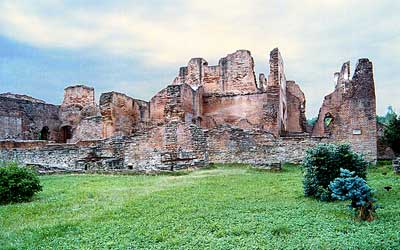 |
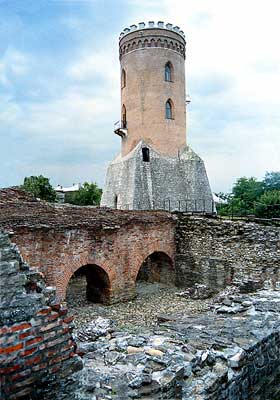 Sunset Tower |
We rolled into Bucharest that afternoon, home for Radu and Lucy, and Didina's former home. The heat and humidity were oppressive, and the sky was clouded over, making everything a dingy gray. The path of totality had passed over the city, but we heard that there were only a couple of spots where people had gotten a break in the clouds and had seen the eclipse.
|
We parked our stuff in Radu's condo, and then went out to see a few sights. At one time, Bucharest was quite a beautiful city, and was dubbed "the Paris of the East." However, Ceausescu put an end to much of that. He leveled the old, historic city center (to be exact, 12 churches, three monasteries, two synagogues, and 7000 homes) and built a ghastly "imperial palace" for himself, based on-of all things-North Korean architecture. It was officially known as the Casa Republicii, then as the Casa Poporului, but was commonly referred to as Casa Nebunului, or "madman's house." This building is the third-largest in the world (after the Pentagon in the US and Potala Palace in Tibet), and its construction very nearly bankrupted the country. When fully lit, it consumes Bucharest's entire electricity supply for a day in four hours. Shortly after it was completed, Ceausescu was overthrown. Today, it houses the Romanian Senate and Parliament. Just across the street, workmen were beginning to dismantle an outdoor stage that had been set up for a concert by opera singer Luciano Pavarotti, which had taken place the previous evening. Pavarotti is somewhat famous for constantly mopping his face with a big handkerchief during performances, and that's usually in air-conditioned concert halls. It's hard to imagine the Big Guy sweating it out in a tux in this sort of heat. |
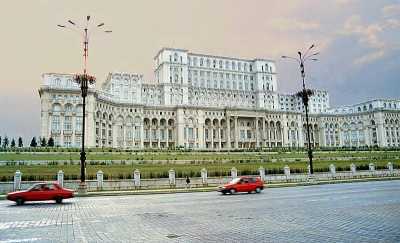 Ceausescu's Big House |
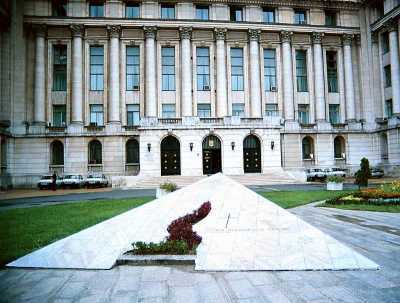 The revolution balcony |
We also stopped at the Piata Revolutiei, or Revolution Square. Off on one side of the square is a building where everything came unglued for Ceausescu. On December 21, 1989, he was making a speech from the balcony of this building (then the Communist Party headquarters), and the people finally snapped. Ceausescu and his wife escaped the building by helicopter, but were captured and executed in Targoviste four days later. That was followed by a brief period of civil war in Romania, where people had been shooting at each other in the streets. Radu and Didina, who had lived through all this, pointed out to us the places where artillery emplacements had been pounding the surrounding buildings. Oddly enough, the party headquarters building emerged relatively unscathed. Today, there is a simple monument under the infamous balcony. |
Saturday, we headed down to the post office to get stamps for postcards. Yikes. There was only one window open, and a bit of a line. When we got to the front, Radu asked the clerk how much postcard stamps to America were. She didn't know. But she took a guess. OK, we said, we'd like 20 of those. She didn't have 20, only 15. Radu said he knew of another place nearby that also sold stamps, so he went off down there while we went about using the stamps we could get. The first thing we noticed was that the glue on the stamps didn't work very well. I noticed other people around using glue sticks on the stamps, apparently this is a normal condition. Radu came back, and had more stamps...but these were cheaper than the ones we'd gotten from the postal clerk. We stuck the stamps on as best we could, and dropped our cards in the mailbox, not quite sure that any of them would ever reach their destinations. All of them finally did, but one of my cards took two months to make it.
Small world department: while we were at the post office, I noticed a woman right across the counter from us who was writing a letter addressed to someone in South Gate, California, which is where Pam lives.
Then we set off to see the Royal Palace, built in 1927 by the Romanian king Carol II. Later rulers were unimpressed with the building, and lived elsewhere. While waiting for the next English tour to begin, we strolled around the nearby botanical gardens.
 Your photo tax lei at work... |
By this time, we were becoming accustomed to the "photo tax" that many historical places charge if you want to take pictures. It's one of the ways Romania is really missing out on making serious tourism money. The tax is usually a trifling amount, and is really just annoying. But then you find that many paces offer hardly any souvenir merchandise, such as postcards or guidebooks, for sale; some places, none at all. At the Royal Palace, they have a photo tax, but then they don't let you take any pictures except in the cellar, which is really not much more than a brick corridor. This wouldn't be a big deal, except they also didn't have much by way of their own photos available for sale. There was a slim guidebook with photos, but they only had one copy of it in the tour office. When Pam and Kathy both wanted one, they sent somebody to another building, and they finally came back with one more. |
We still weren't finding much by way of eclipse souvenirs, other than the occasional post card or something. We spotted a guy wearing a really nice eclipse T-shirt, and asked him where he got it. He said that the shirts were made only for export. We were just in the wrong country to buy Romanian eclipse stuff. The only reason he had one is because he worked for the company that made them.
There's a lot of interesting stuff to see and do in Romania, and it could probably become a very popular tourist destination, and a lot of Romanians could make a lot of money. But far too many people there still don't quite get it.
PAGE: 1 | 2 | 3 | 4 | 5 | 6 | 7 | 8 | 9 | 10 | 11 | 12 | 13 | 14